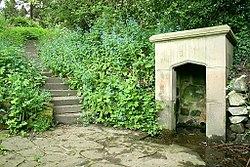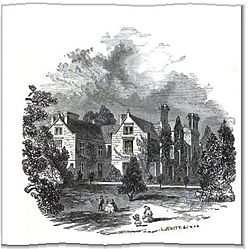Kings Newton
Kings Newton is a village in Derbyshire, just to the north of Melbourne. The Holy well (pictured) was constructed around 1660, but has been refurbished at the end of the twentieth century.[1]
History
Unlike many villages in Derbyshire, Kings Newton is not mentioned in the Domesday book and is a "new town". Originally the hamlet was called Newton but the prefix of Kings was added to differentiate it from other Newtons in the surrounding counties.
After the successful campaign at the Battle of Sobraon, Henry Hardinge was created Viscount Hardinge of Lahore and of Kings Newton in the County of Derby, with a pension of £3,000 for three lives. Why this small village was chosen for his honour is unclear.
The hall illustrated was built in 1560 and was extensively damaged by fire in 1859.[2] It was fully restored in 1910 by Cecil Paget and his first wife. The illustration is from a book of poetry by local naturalist, John Joseph Briggs, whose poem about the Trent was the title of his poetry book.[3]
Notable residents
- Marjorie Bates, 20th-century artist was born here in 1883.
- John Joseph Briggs, Naturalist lived here and published a History of Melbourne[4]
- Cecil Paget, locomotive engineer and railway administrator, lived in the Hall 1910-1936[5]
References
- ↑ Living Springs journal. Accessed 29 January 2007
- ↑ 'Kings Newton village in South Derbyshire: Information and photos' Derbyshire UK, accessed 2009-08-16
- ↑ The Trent, and other poems By John Joseph Briggs pub. 1859
- ↑ John Joseph Briggs in the Dictionary of National Biography 1866
- ↑ 'The gentry: the Paget family' Remembering Sutton Bonington
Outside links
| ("Wikimedia Commons" has material about Kings Newton) |
- Location map: 52°49’55"N, 1°25’23"W

